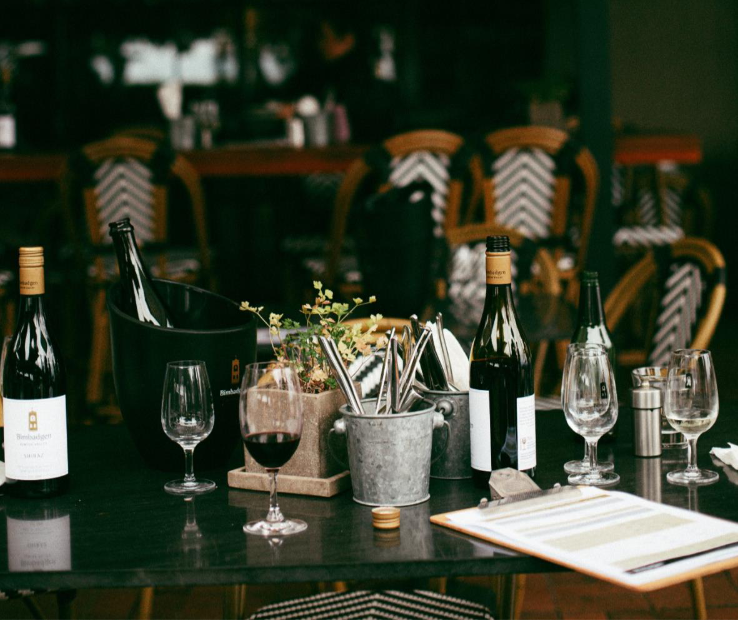Failproof Digital Marketing Tactics Restaurants Can Use to Gain a Competitive Edge (with Examples)
If you’re a restaurant owner or a restaurant manager and online marketing hasn’t been on your mind until now or it’s been lying on the back burner, it’s time to kick your website marketing plans into high gear. Because in 2020 everything is happening online.
It used to be the busy lives that drove us to use devices and the internet to shortcut our way to everything from outfit to grocery shopping, to getting dinner and planning our vacations. It seemed like we were slowly but steadily heading to digitalizing everything in our lives anyway. And here we are now dealing with a global pandemic with little to no options other than doing everything online.
Food is essential for living and it’s naturally also become one of the central elements of the online game even before ordering food online became a necessity. There’s always been a lot of online buzz around new restaurants, new cooking techniques, sourcing local food or ingredients, new diets, food blogs, food photography.
Instagram has 403 million #food posts and another 237 million #foodporn posts. Every restaurant now needs an online presence. If you’re not high up in local searches, you’re not active on social media and if your restaurant’s menu and delivery options are scarce, it’s like you don’t exist. Because if getting noticed online used to be optional, 2020 made it mandatory.
To draw in more people and put your brand’s name on the restaurant and food map, you need a good marketing plan. Don’t even have one? Not sure what a website marketing plan for restaurants looks like? We’ll show you 5 sure-fire marketing strategies guaranteed to help you attract more customers and set your restaurant and brand apart.
Make the best marketing plan for your business with these 5 guaranteed website marketing strategies for [restaurants]:
- Everything you do, do for mobile: Optimize your website for mobile devices.
- Focuson what matters: Optimize your website for [Local SEO].
- Make quality content, get more engagement: Become a social media rockstar.
- Get the most out of knowing your customers: Build and grow your client database.
- Simplify and win: Shorten the distance between potential customers and your dishes with online order and delivery options.
1. Everything you do, do for mobile: Optimize your website for mobile devices. Your website and any marketing effort relating to your business must be focused on where the action is happening. If you take a look around you anywhere you are–in the park, on a bus or at the mall food court, you’ll see most people are on their phones. So that’s where you need to be, too. Not on your phone, but theirs.

First and foremost, how optimized your restaurant’s website is for mobile will weigh a lot in its search engine ranking. The longer users spend on your website (provided it’s user-friendly and responsive on all devices), the better it will do in search results. Mobile-friendly websites are especially important for businesses people search for on the go. And restaurants are definitely such businesses. Just think of how you found the last restaurant you went to.
If your eatery’s website is mobile-ready, it’s already more appealing to users. Because who doesn’t like nice things that work well and have all the right answers? You can’t go wrong with a quick-loading, easy to navigate and share website with intuitive features.
Visitors will more likely increase the amount of time they spend visiting different pages of the website when it’s an enjoyable experience. That will give you just enough time to wow them with [awesome content] and turn them into customers. Mobile-friendly websites are also more likely to be shared among friends or on social media.
Easy ordering, map location, and instant call features will lead to more orders and reservations. This feature also works to inspire trust in visitors. It shows you care about their comfort and streamlining their journey through the sales funnel. Plus, a non-responsive website will definitely tell them you’re not hip because that’s so 2004.
You can take on this task yourself, hire a web developer or outsource to [specialized web design companies] to give you a fully updated, fully functional website.
2.Focus on what matters: Optimize your website for [local SEO]. Say you just landed in Atlanta and you’re looking for a place to eat. You’re not familiar with the area, so you take your phone and search online for ‘good restaurants nearby’. Or, more specifically, ‘best Indian restaurant in Atlanta’s Westview neighborhood’.

As you’ve probably figured out, all roads eventually lead to your website’s search engine rankings. Luckily, [local SEO] is easier and faster to implement than more complex SEO tactics. You’re competing with a smaller pool of competitors than you would for national or international SEO.
Plus, you have a lot of cool [on-site] and [off-site] options to boost your website’s ranking. Relevance is the number one factor helping your local SEO. Search engines use many ranking factors to deliver the most appropriate and useful content to users and relevance is high on their lists. For starters, your website’s content must be optimized for local searches with more technical tactics like H1 tags, meta descriptions, and URLs.
Then, you’ll need to expand your reach to local audiences through local listings and review website profiles. Your contact data on your website, as well as in your listings, must always be updated and accurate. You don’t want to be sending potential customers on a wild goose chase. On to reviews.
They are the number one factor potential customers care about when it comes to restaurants. We may not all like the same shoes, but we all enjoy good food. So, if hundreds of happy customers vouch for your amazing dishes, chances are everyone will. That’s also the recipe for building a strong and reputable brand.
Always engage with your customers online. Respond to good and bad reviews and encourage clients to keep writing them with fun incentives or rewards. Google My Business, Google+, Yelp, Tripadvisor, and AllMenusare only a few of the local listings that will boost not only your reach but your search engine rankings. It also makes it more comfortable and easy for customers to find or call you to make a reservation or an order.
3. Make quality content, get more engagement: Become a social media rockstar. It may sound like a daunting task but fear not. Social media platforms are a friendly territory for restaurant businesses. There’s always room for one more awesome dish someone is preparing to indulge in and one more restaurant trying to steal people’s hearts.
While their algorithms may not always be clear to everyone, platforms like Instagram and Facebook are still a great place for foodies and restaurants alike. It’s where passionate restauranteurs, cooking aficionados, and lovers of food can share thoughts, ideas, pictures, and opinions. There’s always something to talk about when it comes to food.

Setting up social media accounts for your restaurant business is essential. It’s how you can gain exposure and trust, get more followers, and drive customer engagement. Here are a few simple steps you can start off with to make your restaurant unique and attract more customers:
- Set up the right accounts for your business– Focus on the platforms where you’ll most likely find your specific audience. It may depend on age, location, or other factors, so don’t skimp on doing a little research to find where your efforts have the best chances of making an impact.
- Invest in amazing photos– An image is worth a thousand words and it may be worth even more when a hungry person is looking at a picture of a yummy, gourmet dish. Always focus on quality content and keep things consistent. Research what times of the day and what types of content perform best and see what others are doing to get inspiration or find your restaurant’s niche.
- Promote user-generated content– Find fun hashtags your customers can use when they share a photo of your dishes on their social media accounts. Use [influencer marketing] strategies to build trust and get more engagement. Do fun challenges, or create a one-of-a-kind, signature dish or cocktail to spice things up and establish your brand online.

- Set up the right accounts for your business– Focus on the platforms where you’ll most likely find your specific audience. It may depend on age, location, or other factors, so don’t skimp on doing a little research to find where your efforts have the best chances of making an impact.
- Invest in amazing photos– An image is worth a thousand words and it may be worth even more when a hungry person is looking at a picture of a yummy, gourmet dish. Always focus on quality content and keep things consistent. Research what times of the day and what types of content perform best and see what others are doing to get inspiration or find your restaurant’s niche.
- Promote user-generated content– Find fun hashtags your customers can use when they share a photo of your dishes on their social media accounts. Use [influencer marketing] strategies to build trust and get more engagement. Do fun challenges, or create a one-of-a-kind, signature dish or cocktail to spice things up and establish your brand online.
- Show off your staff– You can show your stuff, too. But show your team. Go backstage and let your restaurant’s followers see what your business is all about. One example is to use your restaurant’s chefs or your cooks as the brand’s ambassadors. They can share their knowledge and experience with your audience and provide great tips for cooking enthusiasts. In turn, they won’t only engage more, they are also more likely to share your content with their friends, family, and own followers. Give your followers access to your brand’s values and build their trust by being transparent and open.
- Make fun campaigns– Come up with fun stuff to put your restaurant’s name on the map. Like a campaign to get people out of their sweatpants and back in their Sunday best. But on Thursday and not for going out, but for staying in. Give it a catchy name like “no sweatpants Thursday” and watch it take off and attract more customers.
4. Get the most out of knowing your customers: Build and grow your client database. Investing in your website’s [mobile-friendliness], in [local SEO] and in your brand’s [social media presence] means that you’ll get to reach a lot of potential customers.
It’s only natural that the next step is making the most out of that reach.
Getting information from your audience and customers about their likes, dislikes and common characteristics can supercharge your digital marketing efforts.
The best 2020 marketing strategies for restaurants have this starting point in common: knowing theaudience.
Once you have the information you need, you can tailor your [website promotion strategies] and improve your reach and conversion rates by giving people exactly what they want.
You can also drive more engagement and use your audience’s contact information to stay in touch with them and send them news or offers. A customer database can have many useful functions for a restaurant’s marketing endeavors and deliver a lot of results.
You can use your customer database to:
- Set up email-campaign with personalized messages when you want to promote a special offer or a new menu item
- Tell your brand’s story with weekly newsletters with behind-the-scenes action and information about your brand’s values
- Do surveys to know your audience even better
- Attract more follower and customer engagement with special offers, contests or other incentives
- Establish your restaurant as a local brand by starting collaborations with local produce suppliers and inviting customers to become a part of a local business support group.
5. Simplify and win: Shorten the distance between potential customers and your dishes with online order and delivery options.

Whatever your marketing plan for your restaurant’s website is and whatever marketing strategies you apply to drive customer engagement and attract more business, you’ll need to top everything off with the ultimate pièce de résistance: the call-to-action button.
For a restaurant, the CTA button means giving your website visitors a chance to order online and have their meal delivered pronto. People will still call, they’ll still make reservations and those are great features to have on your page. But 2020 has made it all about online orders and fast delivery.
Your restaurant’s website has to show more than who you are, what you stand for, and how amazing your food is. It needs to be easy to use, give users fast information about everything they need, and top everything off with an “order now” button.
- What you’ll need is:
- A clear, simple, uncluttered menu page
- Astonishing pictures of the dishes you offer and a simple description of the ingredients•An easy-to-fill order form.
- Fast and uncomplicated delivery options.
Online marketing is an ever-evolving promotion tool for any type of business and the digital era is just beginning. You have to be open to learn and grow with the trends. Adapt to what’s fresh and in demand and see what people respond to. Using our online marketing strategies, we guarantee your restaurant will reach new heights and stay on top for years to come.



